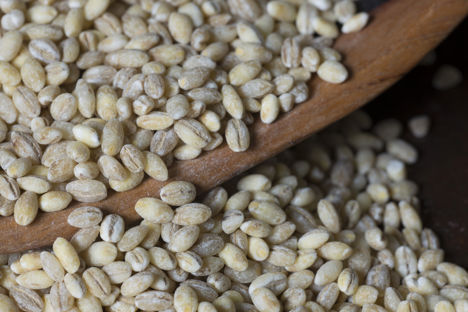Pearl barley has seen a big revival recently thanks to its high nutritious value and crunchy texture. It is most often cooked in stocks or soups, where it absorbs all the flavours from the liquid. This means that the taste of the grain largely depends on what it's cooked in.
Pearl barley is harvested from ears of barley. They're processed so that the hull is removed, and at this point, is known as 'hulled barley', 'dehulled barley' or 'pot barley', which is more prevalent in America than Britain. The bran is still round the grain, which gives it extra nutrients, but also increases the cooking time. For the grain to become pearl barley, it needs to be polished or 'pearled'. This process removes the outer bran, and gives the grain a shiny appearance.
Pearl barley has a neutral-cereal taste. Its most distinctive feature is its texture. The grains also thicken soups and stews, imparting a creaminess which means that the liquid coats the back of a spoon.
Praised for its high nutritional levels, pearl barley is found in lots of health food shops, as well as the health food, or grain aisle of most mainstream supermarkets.
How to cook with pearl barley
As with most grains, it is a good idea to rinse pearl barley before cooking with it — particularly if adding straight to a soup or a stew. Cooking can be accelerated by using a pressure cooker. But the most common method is to add the grains straight to a broth or stew. Cooking this way, at a gentle simmer, takes approximately 30 minutes.
Another option is to use pearl barley as a substitute for rice in a risotto - it has a similar capacity for absorbing liquid and the cooking time will be roughly the same.
If you want to add pearl barley to a soup or stew but don’t want the barley to thicken it then cook it separately first. Boil in water for 20-30 minutes and rise before using.
What pearl barley goes with
Pearl barley is often added to a Scotch Broth. The simple, stocky flavours work well with this robust grain, as demonstrated by William Drabble's Lamb, potato and pearl barley stew, Lisa Allen's Lancashire hot pots, and Phil Howard's Pearl barley cooked in stock, which he uses to accompany mousseline of grouse. Don't be afraid to use more exotic flavours. Pearl barley is a neutral vehicle for strong herby or spiced flavours - as with Smeddle's pot-roast spiced shoulder of lamb with chorizo and pearl barley.
Get in touch
Please sign in or register to send a comment to Great British Chefs.



